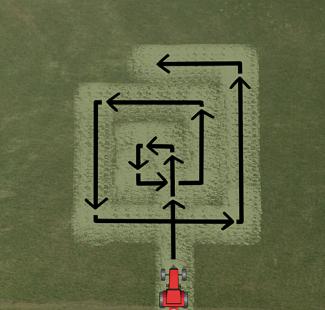You can manage your grasslands to benefit both livestock and wildlife. Overviews of these management practices are provided below.
Contact your local private land conservationist for more information.
Title
Grazing
Grazing Systems
Grazing can be continuous or rotational. "Continuous" means keeping livestock on a single field over an extended period of time, if not permanently. Rotational grazing involves moving livestock between at least two pasture units.
Continuous grazing often leads to:
- Poor forage production
- Overgrazing of palatable plants
- Soil erosion, which allows unwanted vegetation such as woody plants to grow and thrive
When grasses are overgrazed, livestock suffers because there is less forage, and wildlife suffers because little habitat remains for them to use.
To grow well, all plants need to have enough leaf area left on them for photosynthesis to occur. This is usually a minimum of 2–4 inches.
Rotational grazing:
- Allows grasses and forbs to recover between grazing periods
- Allows grasses to maintain healthy root systems
- Allows for better forage during the next grazing period
In spring, allowing grazing units to rest also gives wildlife a chance to use residual growth for nesting and cover. Rotating livestock between several units can make it an even better management tool. While a large, multi-unit grazing system takes more time and effort to build and manage, it pays off in better forage, livestock production, and wildlife habitat.
Stocking Rate
It is very important to balance the size of your herd with available forage. If you allow too many cow-calf pairs to graze one or several units, then it probably won't make any difference what grazing system you use — you still won't have enough forage.
Overstocking leads to overgrazing and decreased grass production. You will then be forced to use more fertilizer to try and improve the pasture and feed more hay during times when you would not normally need to do so.
Information and workshops on managed grazing systems are available from your county USDA service center.
Title
Haying
When to Cut Hay
Timing is one of the most important factors in haying. Cutting too early will reduce production, and cutting too late will decrease quality and prevent grasses from building up root reserves before winter dormancy. This weakens the stand of grass and reduces or eliminates cover for wildlife. It is important to hay when quality and quantity can be optimized.
If you're not sure when to hay, MU Extension can advise you about the best times.
How Much to Cut
Cutting height is another important factor to keep in mind, but most managers ignore it. With today's disk mowers that cut nearly at ground level, it is even more important to cut hay at a height that will allow those grasses enough time to regrow and build up their root reserves before winter. Try to leave 4–6 inches above the ground.
Mow from the Inside Out
Wildlife are often killed during haying operations, which continuously herd them toward the middle of the field as it is cut. Then panicked animals are often killed during the final passes with the mower, or they are subject to predation as they try to flee across the recently mowed field. Consider mowing hayfields from the inside out to help reduce wildlife losses as shown here.
Title
Fertilizing
Both haying and grazing remove nutrients from the soil. You can apply fertilizer and agricultural limestone to a field, but it's best to do these practices only after conducting a soil test.
A soil test will
- Tell you if any nutrients are low in your soil
- Allow you to determine the optimum amount and what kind(s) of fertilizer you need to apply
- Possibly save you money and prevent environmental harm since you won't be using more fertilizer than the soil needs (Excess fertilizer will usually run off and get into ponds and streams.)
- Show you if your soil is acidic, and if so, how much lime you will need to bring the soil back to the desired level
You can get help interpreting the soil test from your local MU Extension office.
Title
Overseeding with Legumes
Legumes, such as clovers and lespedezas, are nitrogen-fixing plants, which means they can remove nitrogen from the air and add it to the soil. Thus these plants make nitrogen available for other plants to use.
Legumes can:
- Reduce the amount of fertilizer you need to apply to your grassland
- Improve the forage quality (forage legumes are very palatable and high in protein)
Several factors can affect the success of overseeding an existing grassland with legumes:
- Method used to overseed
- Soil moisture levels
- Timing of the overseeding
Consult your local NRCS office or MU Extension office for advice on which species of legumes to use and what time and method to plant them.
Remember, like grasses, if legumes are mowed and/or grazed too short, too often, or too late in the year, they will die.























